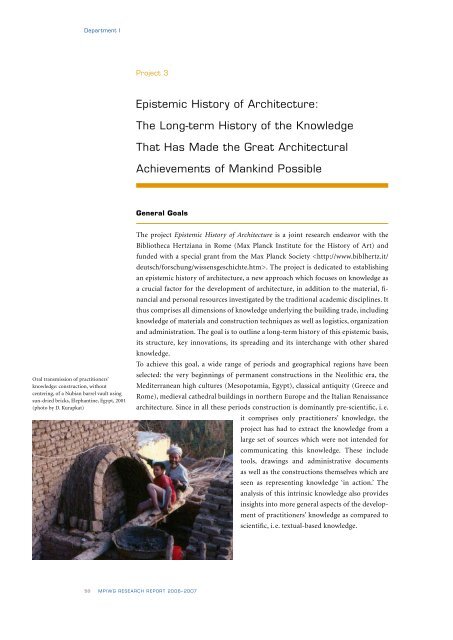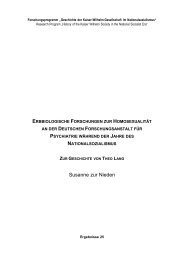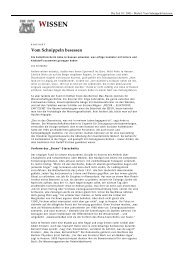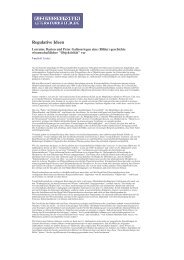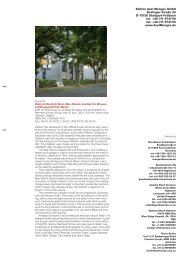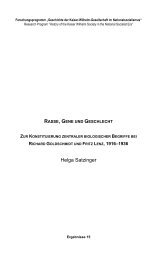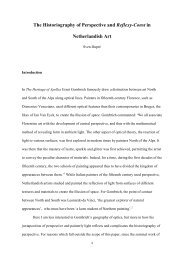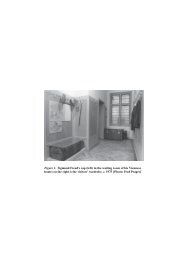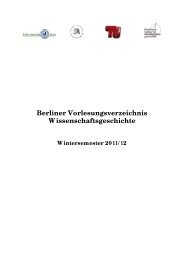Max Planck Institute for the History of Science
Max Planck Institute for the History of Science
Max Planck Institute for the History of Science
You also want an ePaper? Increase the reach of your titles
YUMPU automatically turns print PDFs into web optimized ePapers that Google loves.
Department I<br />
Oral transmission <strong>of</strong> practitioners’<br />
knowledge: construction, without<br />
centering, <strong>of</strong> a Nubian barrel vault using<br />
sun-dried bricks, Elephantine, Egypt, 2001<br />
(photo by D. Kurapkat)<br />
Project 3<br />
epistemic history <strong>of</strong> architecture:<br />
<strong>the</strong> Long-term history <strong>of</strong> <strong>the</strong> Knowledge<br />
that has Made <strong>the</strong> Great architectural<br />
achievements <strong>of</strong> Mankind Possible<br />
General Goals<br />
The project Epistemic <strong>History</strong> <strong>of</strong> Architecture is a joint research endeavor with <strong>the</strong><br />
Biblio<strong>the</strong>ca Hertziana in Rome (<strong>Max</strong> <strong>Planck</strong> <strong>Institute</strong> <strong>for</strong> <strong>the</strong> <strong>History</strong> <strong>of</strong> Art) and<br />
funded with a special grant from <strong>the</strong> <strong>Max</strong> <strong>Planck</strong> Society . The project is dedicated to establishing<br />
an epistemic history <strong>of</strong> architecture, a new approach which focuses on knowledge as<br />
a crucial factor <strong>for</strong> <strong>the</strong> development <strong>of</strong> architecture, in addition to <strong>the</strong> material, fi-<br />
nancial and personal resources investigated by <strong>the</strong> traditional academic disciplines. It<br />
thus comprises all dimensions <strong>of</strong> knowledge underlying <strong>the</strong> building trade, including<br />
knowledge <strong>of</strong> materials and construction techniques as well as logistics, organization<br />
and administration. The goal is to outline a long-term history <strong>of</strong> this epistemic basis,<br />
its structure, key innovations, its spreading and its interchange with o<strong>the</strong>r shared<br />
knowledge.<br />
To achieve this goal, a wide range <strong>of</strong> periods and geographical regions have been<br />
selected: <strong>the</strong> very beginnings <strong>of</strong> permanent constructions in <strong>the</strong> Neolithic era, <strong>the</strong><br />
Mediterranean high cultures (Mesopotamia, Egypt), classical antiquity (Greece and<br />
Rome), medieval ca<strong>the</strong>dral buildings in nor<strong>the</strong>rn Europe and <strong>the</strong> Italian Renaissance<br />
architecture. Since in all <strong>the</strong>se periods construction is dominantly pre-scientific, i. e.<br />
it comprises only practitioners’ knowledge, <strong>the</strong><br />
project has had to extract <strong>the</strong> knowledge from a<br />
large set <strong>of</strong> sources which were not intended <strong>for</strong><br />
communicating this knowledge. These include<br />
tools, drawings and administrative documents<br />
as well as <strong>the</strong> constructions <strong>the</strong>mselves which are<br />
seen as representing knowledge ‘in action.’ The<br />
analysis <strong>of</strong> this intrinsic knowledge also provides<br />
insights into more general aspects <strong>of</strong> <strong>the</strong> development<br />
<strong>of</strong> practitioners’ knowledge as compared to<br />
scientific, i. e. textual-based knowledge.<br />
50 MPIWG ReseaRch RePoRt 2006– 2007


